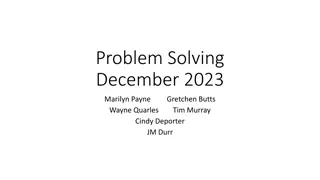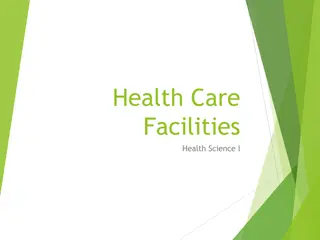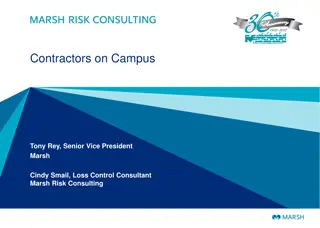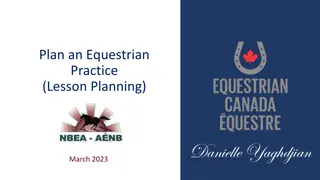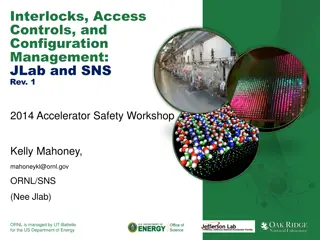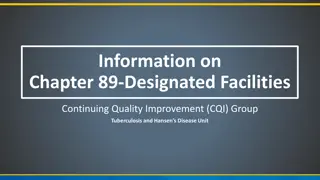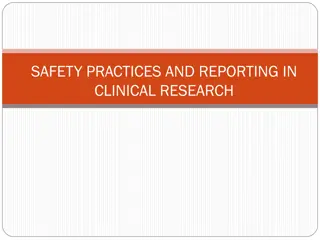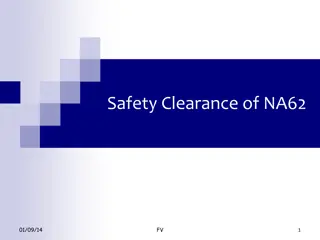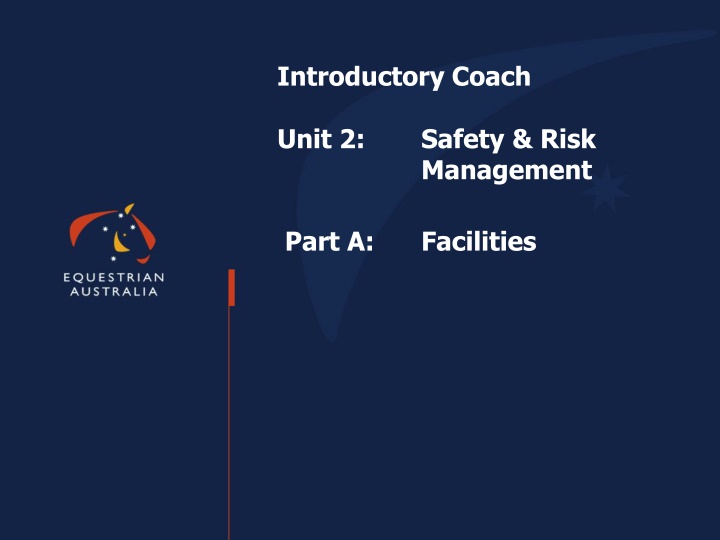
Safety Guidelines for Equestrian Facilities
Recognize the characteristics of a safe equestrian center including fencing types, design considerations, and separation of horses, traffic, and pedestrians. Learn about safe parking areas, public areas, and indoor arenas to ensure a secure environment for all. Regular inspections, proper lighting, and ventilation are key factors in maintaining safety.
Download Presentation

Please find below an Image/Link to download the presentation.
The content on the website is provided AS IS for your information and personal use only. It may not be sold, licensed, or shared on other websites without obtaining consent from the author. If you encounter any issues during the download, it is possible that the publisher has removed the file from their server.
You are allowed to download the files provided on this website for personal or commercial use, subject to the condition that they are used lawfully. All files are the property of their respective owners.
The content on the website is provided AS IS for your information and personal use only. It may not be sold, licensed, or shared on other websites without obtaining consent from the author.
E N D
Presentation Transcript
Introductory Coach Unit 2: Safety & Risk Management Part A: Facilities
2a.1 Characteristics of Safe Equestrian Facility Coaches are required to recognise characteristics of a safe equestrian centre including: Advantages/disadvantages of fencing types Dangerous features Design & safety consideration to minimise fire risks Keeping horses & pedestrians separate Keeping horses & traffic separate Keeping facilities tidy and storage of equipment EQUESTRIAN AUSTRALIA
2a.1 Characteristics of Safe Equestrian Facility Parking Areas and loading/unloading areas should be: Regularly inspected for hazards Fenced and Gate closed if provided to prevent horse escape from property large enough for vehicles to turn Surface safe for vehicles not boggy or slippery Surface safe for horses not boggy or slippery sufficient room for other vehicles/horses to pass by Gate wide enough for truck/float access Suitable area to tack and un-tack If busy, separation between driveway and parking area EQUESTRIAN AUSTRALIA
2a.1 Characteristics of Safe Equestrian Facility Public Areas Should be regularly inspected for hazards If possible the public should be kept clear of horses Viewing areas should be separated from riding areas Car parking for cars only should be separate from horse truck/float parking Spectators/pedestrians should be kept separate from horse areas/activities via barriers physical barrier if possible, but signage and supervision can also be used. EQUESTRIAN AUSTRALIA
2a.1 Characteristics of Safe Equestrian Facility Indoor arenas should be/have: ideally 20x40 or more, depending on the activity inspected prior to the activity Gate to be kept closed, should open outwards or slide Sufficient lighting and ventilation Ideally the arena surrounds should be 1.2m high, preferably made of wood panelling/rubber that would resist penetration of horse s kick Panelling should be inclined away from the inside of the arena at top for safety of riders legs/feet Ideally facilities can be altered for rider numbers and skill level EQUESTRIAN AUSTRALIA
2a.1 Characteristics of Safe Equestrian Facility Outdoor arenas should be inspected prior to the activity suitably fenced eg. Post & rail (not wire or electric tape) If gate provided keep closed during riding Gate should open outwards or slide Arena edge to be free of protruding objects Ideally facilities can be altered for rider numbers and skill level EQUESTRIAN AUSTRALIA
2a.1 Characteristics of Safe Equestrian Facility Arena Surfaces should be: Inspected prior to the activity Non slip Not too hard, should have some give to absorb concussion of horses stride Should not be too soft or boggy Should be a consistent surface Should be free draining In dry/dusty weather watering to be available EQUESTRIAN AUSTRALIA
2a.1 Characteristics of Safe Equestrian Facility The riding environment should be: Reasonably free from distraction/noise/spectators/other animals Adjust lesson length/content depending on weather Hazards removed EQUESTRIAN AUSTRALIA
2a.1 Characteristics of Safe Equestrian Facility Riding in the open The area should be inspected prior to the activity If possible area to be fenced and gate closed Hazards should be clearly marked or made known Terrain should be suitable to riders and horses The going can be varied preferable not too rocky, pitted, boggy or slippery If these conditions can t be avoided then appropriate care should be taken Ideally facilities can be altered for rider numbers and skill level EQUESTRIAN AUSTRALIA
2a.1 Characteristics of Safe Equestrian Facility Equipment should be Safe & suitable for the activity Well maintained Any markers/cones should be safe and not dangerous if stepped on Poles/rails should be min 9cm diametre and approx 4m long. Smooth & not too heavy to lift Wings and uprights made of strong materials with gaps of less than 10cm so horse hooves should not fit through Cross country fences should be inspected each time before use. Ideally facilities can be altered for rider numbers and skill level EQUESTRIAN AUSTRALIA
2a.2 Assess the suitability of an area/facility for a particular activity Take the EA Essential Risk Management and Facilities guideline Break into small groups Choose a venue (workplace/venue of workshop/ state or national EC) Each group to consider at least one aspect of the venue and complete a risk identification, risk measurement and management of the risk including a timeline EQUESTRIAN AUSTRALIA
2a.3 Adapt lessons/equipment/venue to comply with safety considerations Each group to come up with suggestions and adaptations that may be required in the following situations Adapting sessions for number of pupils in group Adapt lessons for the skill level of pupils Adapt equipment/facilities to suit the skill level and/or number of pupils Strategies for lesson adaptations when the coach has no control over the venue? EQUESTRIAN AUSTRALIA
Introductory Coach Unit 2: Safety & Risk Management Part B: Accident & Injury
2b.1 Apply First Aid Ensure that you always have: human and horse first aid kit on hand there is always someone qualified to administer first aid a list of emergency contacts readily accessible including Vet, Fire, Doctor, Ambulance etc a phone readily available an accident and emergency procedure planned and practiced EQUESTRIAN AUSTRALIA
2b.2 Accident/Incident Procedures Action to take: Stay calm, halt the ride, dismount if necessary Attend to injured person Have any loose horses contained Follow first aid procedures Phone for medical or vet assistance Never admit liability EQUESTRIAN AUSTRALIA
2b.2 Accident/Incident Procedures Discuss basic first aid procedures: Pressure for bleeding Ice/cold hosing for bruises and sprains Broken bones When to call the ambulance When to call the vet When to send the rider to doctors with parent/guardian EQUESTRIAN AUSTRALIA
2b.3 Identify common safety threats The most common dangers/safety considerations: 1. Horse rider mis/match 2. Tack/gear 3. Rider attire 4. Helmets 5. Poorly organised ride 6. Inappropriate facilities 7. Inappropriate activities EQUESTRIAN AUSTRALIA
2b.3 Safety Considerations 1. Rider Assessment Establish previous experience and assess standard of riding Ensure Parent/Guardian consent Disclaimer signed and medical disclosure provided Suitable activities Suitable number of riders for the activity Provision for special needs EQUESTRIAN AUSTRALIA
2b.3 Safety Considerations 2. Horse Assessment Horses should be: Suitable for the rider standard and activity Horse is matched to the rider for size and weight carrying Welfare of the horse is paramount and consideration of the horses suitability, comfort, soundness, injures, age, fitness and condition are essential EQUESTRIAN AUSTRALIA
2b.3 Safety Considerations 3. Tack and Gear Tack/Gear should be: Safe and appropriate for the activity Well maintained and clean, especially stitching and signs of wear Horses should be familiar with equipment/tack Correctly fitting considering horse welfare and comfort If fitting is incorrect alter it if possible If gear is dangerous and cannot be altered the rider cannot join the lesson EQUESTRIAN AUSTRALIA
2b.3 Safety Considerations 4. Rider attire - should be Safe & suitable for the activity Helmet of required standard correctly fitting and chin strap done up Footwear to have light tread or smooth sole and small heal Jodhpurs or suitable jeans style, preferable long sleeve tops that are not too loose fitting Body protectors recommended for all jumping and cross country activities Whips & spurs to comply with EA rules Gloves optional but recommended for lungeing Sun protection is essential EQUESTRIAN AUSTRALIA
2b.3 Safety Considerations 5. Appropriate facilities Ideally facilities should be in line with the safe facilities Group Discussion Each person to suggest one thing that could go wrong if the ideal features were not possible/available? How could these scenarios be remedied? What if the coach is not in control of the facilities? How could the lessons be altered? EQUESTRIAN AUSTRALIA
2b.3 Safety Considerations 6. Lesson Organisation There is a reason for lesson planning!! Group to discuss what could go wrong in the event of: Poorly organised lesson Poorly organised ride/group control Lesson content/activities inappropriate horse/rider experience and skill level Dangerous horses in the group How could these situations be remedied? EQUESTRIAN AUSTRALIA
2b.4 Problems associated with horses Discuss the : Behaviour of entire horses Behaviour of ex racehorses Hot behaviour What are some strategies to avoid accidents with these types of horse? EQUESTRIAN AUSTRALIA
2b.5 Incident Recording and Reporting Always, always, always fill in incident report form and keep records Ask any witnesses to provide a statement or verify the incident report View incident forms as a risk management tool Use incidents as a prompt to review your facilities and practices things always change!! Send incident report to Aon Further details covered in Part 4 Insurance EQUESTRIAN AUSTRALIA
Introductory Coach Unit 2: Safety & Risk Management Part C: Safety for Riders & Coaches
2c.1 Appropriate Riding Attire/Equipment/Gear Check Gear Check is an important part of the Coach s legal safety responsibility Should be done prior to every lesson If a rider provides their own gear the coach should advise the rider that the care and maintenance of their gear is their responsibility The coach is to check the general safety of the gear EQUESTRIAN AUSTRALIA
2c.1 Appropriate Riding Attire/Equipment/Gear Check The Welfare of the Horse is THE priority in checking gear. If the fit is not ideal but can be altered eg extra padding then the rider can participate If the gear poses a threat to the horse s comfort and wellbeing, and can t be altered, then the rider cannot participate If the gear is dangerous and poses a threat to the rider s safety, and cannot be altered, the rider cannot participate EQUESTRIAN AUSTRALIA
2c.1 Appropriate Riding Attire/Equipment/Gear Check Checking the rider: Ideal footwear = riding boots Acceptable footwear = smooth soled shoes with heel Approved helmet, that is done up and fits properly Attire appropriate for riding, not too loose fitting, hair tied back, no dangling jewellery EQUESTRIAN AUSTRALIA
2c.1 Appropriate Riding Attire/Equipment/Gear Check Checking the horse: The gear should be suitable for the horse and the proposed activity Saddle, saddlecloth and bridle to be correctly fitting and well maintained Shoes/feet in good order Boots/bandages correctly fitted and comfortable EQUESTRIAN AUSTRALIA
2c.1 Appropriate Riding Attire/Equipment/Gear Check Check: Reins & bit for correct fitting and wear Girth/points for wear and adequate tightness Stirrup leathers/irons for wear and correct width Nosebands, martingales, breastplates are correctly fitted and maintained All straps are in keepers Any Whips/spurs used are appropriate EQUESTRIAN AUSTRALIA
2c.2 Coachs role in setting safety standards Coaches have a duty of care to provide as safe as practicable environment for their students, horses and spectators Coaches should lead by example by following the rules that are laid down for riders eg. Wearing appropriate attire including helmets Coaches should discuss with their students the rationale behind safety rules and the importance of maintaining/enforcing these especially gear check, emergency procedures, good group organisation EQUESTRIAN AUSTRALIA
2c.2 OHS Considerations for Coaches Coaches have a safety responsibility is to make sure they don t become accident victims themselves!! Coaches should avoid taking any unnecessary risks when dealing with accidents & horse/rider problems Potential OHS issues for coaches include: Back injury from incorrect/heavy lifting Bites, kicks, treads from a horse, falling from horse Sunburn/skin cancer EQUESTRIAN AUSTRALIA
Introductory Coach Part 2: Safety & Risk Management Part D: Insurance & Legal Issues
2d.1 Coachs Code of Ethics Coaches have as much duty to abide by code of behaviour as they do to provide safe facilities. The ASC has a code of ethics for coaches which EA has adapted for Equestrian Sports Abiding by the Code of Ethics prevents coaches from being in a position where Disciplinary or even legal action could be taken against them EA has Disciplinary By-laws and a Member Protection Policy by which all coaches must abide. EQUESTRIAN AUSTRALIA
2d.1 Coachs Code of Ethics Key items in the EA Code of Ethics Welfare of the horse is paramount including discouraging cruel training methods Uphold equipment/facility safety standards Respect all riders, horses, fellow coaches, officials Conduct themselves in an honest, dignified & controlled manner Keep up to date with developments in sport Discourage the use of drugs in sport Teach respect for the Sport Rules EQUESTRIAN AUSTRALIA
2d.2 Harassment There are 3 types of harassment that need to be considered in the coaching environment 1. Sexual harassment/abuse 2. Discrimination 3. Physical/psychological abuse Harassment can be expressed, implied, physical, verbal or non verbal Harassment is considered unlawful and can result in legal action/criminal charges EQUESTRIAN AUSTRALIA
2d.2 Harassment The recipient must consider the behaviour to be unwelcome It does not matter whether the whether the person harassing intended to offend. Harassment is considered behaviour that a reasonable person would find unwelcome EQUESTRIAN AUSTRALIA
2d.2 Harassment 1. Sexual Harassment, may include: an unwelcome sexual advance or request for sexual favours Unwelcome conduct of a sexual nature (verbally or in writing) Something that a reasonable person would consider offensive, humiliating or intimidating Some examples: Uninvited touching, kissing, embracing, massaging Persistent/instrusive questions about private matters sexual propositions or threats to coerce someone into sexual activity sexual insult or name calling EQUESTRIAN AUSTRALIA
2d.2 Harassment 1. Sexual Harassment Given the above, coaches should ensure they behave in an appropriate manner at all times Avoid jokes/comments that could be considered offensive Since riding is a physical sport and may involve the need to be hands on with a rider, coaches should always ask permission before touching a rider (including during gear check!!) EQUESTRIAN AUSTRALIA
2d.2 Harassment 2. Discrimination Discrimination is treating a person less favourably than others in certain areas of public life on the basis of an attribute or personal characteristic. These can include, Age, gender, race, sexual orientation Physical features such as weight Disability physical impairment, intellectual disability, disease (eg. HIV status) Religious or political persuasion EQUESTRIAN AUSTRALIA
2d.2 Harassment 2. Discrimination There are some exceptions permitted under an application for exemption to state/federal law For example- an exemption to the Discrimination Act/Laws may be granted if the person s disability or physical features pose a threat to the health/safety of that person, any other person/public, property and the welfare of the horse. EQUESTRIAN AUSTRALIA
2d.2 Harassment 3. Abuse - may include Physical abuse (eg. Assault) Emotional abuse (blackmail, repeated demands/requests) Abuse of power that the harasser holds over the harassed Some forms of abuse may constitute a criminal offence eg assault. EQUESTRIAN AUSTRALIA
2d.2 Harassment 3. Abuse Examples include intentionally causing an injury or property damage (even on the sporting field) Abuse/insults directed at other participants, officials, spectators, coaches Can include practical jokes which cause embarrassment or endanger other s safety EQUESTRIAN AUSTRALIA




